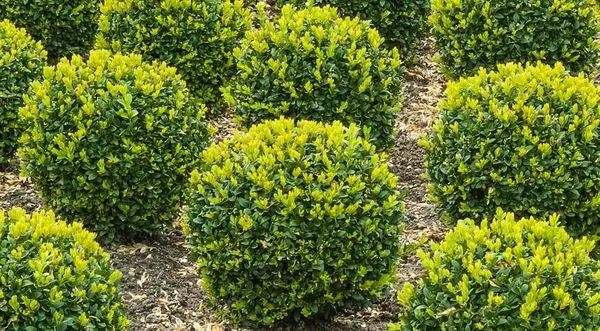Contents
Boxwood, or buxut, is an evergreen shrub of the Boxwood family. The plant is mainly used in landscape design. Due to its durability, elasticity of leaves and stems, the shrub can be given almost any shape. The relative unpretentiousness of some varieties of boxwood allows the gardener not to worry about his wintering. However, unstable crops still need proper insulation. How to cover boxwood for the winter is the topic of our today’s article.
Do shrubs need insulation?
Caring for boxwood in the fall directly depends on the variety of culture. Frost-resistant varieties of buxut are:
- evergreen;
- Hyrcanian;
- Colchian.

Those crops that do not tolerate severe frosts are insulated. However, before the shelter procedure, experienced gardeners carry out a number of preparatory actions:
- Watering. As you know, under the influence of low temperatures, the plant loses moisture, so careful moistening of boxwood in the fall plays an important role. This type of irrigation is considered water-charging. The name is due to the degree of soil moisture – it must be literally saturated with water.
- Mulching. This procedure is an important stage in preparing the buxut for winter. The root area is mulched with peat, pine bark or needles. Dry foliage is also often used as an insulating material, but for many summer residents it is unacceptable. The fact is that fallen leaves are often the habitat of many garden pests. In addition, the foliage, which has absorbed moisture, undergoes rotting, which extends to the plant itself.
- Pruning. The procedure involves the removal of young shoots in order to activate the growth of new branches in the spring. Damaged, dry stems are also cut off.
Video “Preparation of boxwood for winter”
From this video you will learn how to properly prepare boxwood for the winter period.
Shelter methods
Boxwood needs to be insulated in two stages:
- Tying bushes bushes. To do this, they construct a support, to which the base of the bush is tied with twine. The measure prevents damage to branches under the weight of snow.
- Shelter. After the plant is compactly fixed, proceed to the main care procedure – shelter.
An important aspect of a successful wintering of a bush is a properly selected place for its landing. The best option is a shaded garden area. With the onset of a thaw, the rays of the sun can “awaken” the plant, which will provoke the activation of sap flow processes and the early growth of shoots. Subsequent frosts will have a negative impact on boxwood, which is still weak after “hibernation”, up to the death of the bush. Therefore, the shady zone is considered an excellent place for growing buxut.
In central Our Country, the Moscow region, where winters are not as severe as in the north, you can limit yourself to elementary wrapping of a bush with insulation material. It can be burlap, agrotextile, but not polyethylene, which accumulates a large amount of moisture underneath.
In the northern latitudes, where strong and prolonged frosts are considered commonplace, boxwood is insulated more significantly:
- Frame. It is constructed from wooden sticks, wire, plastic, fittings. The main task of the frame is not to bend under the pressure of snow.
- Shelter. Covering material is thrown onto the frame and fixed around the perimeter with weights or earth.
Boxwood bushes, which act as hedges, are insulated with spruce branches. Coniferous branches are distributed along the buxut and tied with ordinary twine.
When to unprotect

Beginning gardeners often make one big mistake – removing insulation too early. You can open the box only after all the snow has completely melted and the air temperature has stabilized. Experienced flower growers recommend accustoming the shrub to the sun’s rays gradually, and removing the insulation in layers. The first layer is removed on a cloudy day to eliminate the risk of leaf burn. When the buxut gets used to the “new mode of life”, you can untie the twine that fixes the branches.
This shrub is one of the most popular materials in the field of landscape design.
Professionals create real masterpieces by cutting boxwood in a certain shape. Its stems are quite soft, and the leaves are dense, which makes it very malleable for the formation of a variety of garden figures, hedges. Do not think that only venerable gardeners can do this, even beginners in this field can safely start a plant and experiment with its shape.
However, one should take into account the fact that its appearance depends on how to prepare the boxwood for winter. Therefore, planting this plant in your summer cottage, you should provide all the conditions for its comfortable growth.










